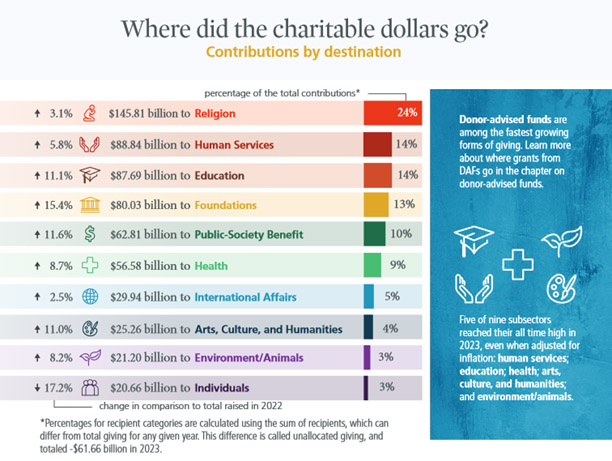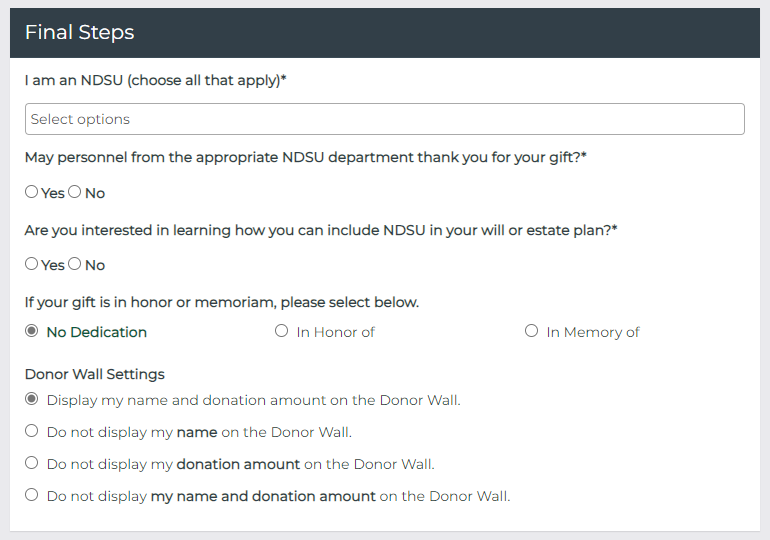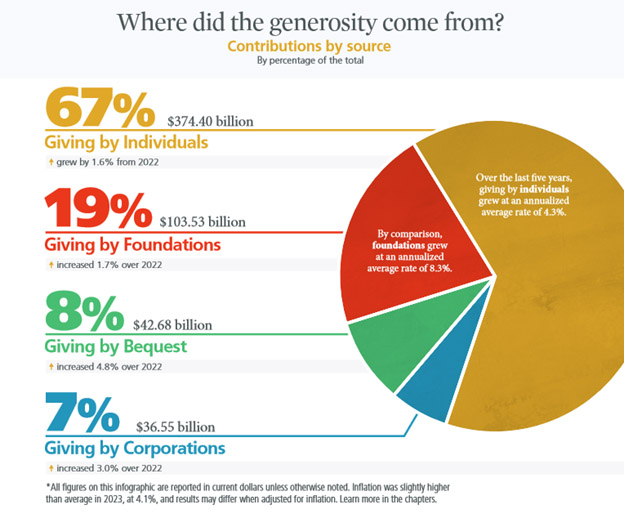fundraising
Giving USA 2024: Looking Ahead
Armed with the data from this year’s Giving USA: The Annual Report on Philanthropy, Giving Institute members and RNL fundraising experts are sharing insights on the state of philanthropy and how savvy fundraisers can look to the future. This annual report, which was released earlier this summer, showed that an estimated $557.16 billion was contributed in 2023 from individuals, corporations, foundations, and bequests. This represents a 1.9% increase in total giving from the previous year, but when adjusted for inflation, reflects an overall 2.1% decrease.
The report is published by Giving USA Foundation, a public service initiative of The Giving Institute. It is researched and written by the Indiana University Lilly Family School of Philanthropy at IUPUI. RNL is a proud, longtime member of the Giving Institute.
In this year’s Giving USA press release, Amir Pasic, PhD, the Eugene R. Tempel Dean of the Indiana University Lilly Family School of Philanthropy, was optimistic when sharing his thoughts about 2023’s findings. “Nonprofits have had to navigate many unpredictable developments in the last few years including a rare decline in total giving in 2022 and changes brought on by the pandemic. While the philanthropic landscape continues to evolve, it’s encouraging to see that giving continues to be resilient.”
A cautiously optimistic outlook, despite continued stress from inflation
Dr. Pasic’s optimism was well supported, with Giving USA reporting promising economic growth in 2023. Most notably, the report indicates that giving grew in all nine categories of nonprofits that receive charitable contributions (religion, human services, education, foundations, public-society benefit, health, international affairs, arts/culture/humanities, environment/animals). Only two of those subsectors, religion and international affairs, saw a decline in giving when adjusting for inflation.Without diving into specific donor data, we can draw some assumptions as to the influence of external circumstances (particularly on the global stage) that may have spurred decline in these areas this past year.
“Americans increased their giving over the previous year despite the elevated cost of living and headlines warning of a possible recession in 2023,” said Josh Birkholz, Chair of Giving USA Foundation and CEO of BWF. “We’re not yet back to the highs of pandemic-era giving, but there are some signs of stability.”
That “stability” in overall revenue, however, may be misleading to fundraising leaders and strategists across the industry. An uptick in revenue may be accounted for in the increasing reliance on mega donors and mega gifts while overshadowing the growing divide between the small number of wealthiest donors and the rapidly decreasing “annual donor” base. Is giving truly on the rebound? Is our philanthropic future bright? And perhaps most important question of all, does this report truly capture what it means to “give” in a modern and digital world?
Philanthropic behavior is often reflective of the social, economic, political environment in which it happens. The global pandemic incited a surge of giving around the world, positively impacting a variety of organizations and individuals in need. It also ramped up a largely digital economy that was already well on its way to dominance. Today’s donors are transferring funds via Venmo or engaging with organizations through social media channels to gauge impact and understand mission. Donors are circling up with like-minded individuals to pool their funds and amplify their impact through collective giving. There is less focus on an organization’s non-profit status when it comes to assessing its ability to create impact. As such “gifts” become harder to track and donor behavior harder to pinpoint in assessments like this one.
Impact of external forces is real
Domestic and international conflicts, and the growing division among Americans as we approach what promises to be another contentious election cycle, will predictably impact giving behavior in the coming months.
Institutions of higher learning have already felt the impact of rapidly changing national or state policy positions (DEI, Affirmative Action, Student Loan Forgiveness, etc.) and there is growing concern about the long-tail impact of those external forces on the student experience as well as alumni and donor engagement. These concerns are heightened by the very immediate and visceral experiences such as campus protests, threats of violence, presidential ousters, and faculty terminations in response to global conflicts and national policy debates.
External circumstances may directly impact individual institutions’ immediate success (i.e., enrollment and retention) and can negatively influence brand reputation and image among a broader set of constituents. The manner and speed with which institutions address these challenges has impacted giving trends as well. Alumni and friends we thought we could always count on may feel very differently about their alma maters in the wake of changing leadership, strong political or issue-based stances, and response (or lack of response) to political unrest on campus. It is more important than ever that we communicate with transparency, compassion, and authenticity with our broader communities during these turbulent times. While your donors may not always agree with your decisions, it does not preclude their ongoing support as long as they feel that your commitment to the larger mission remains steadfast.
What’s your best path to sustainable fundraising?
Let’s talk about how we can help you build a robust donor pipeline, engage the right donors at the right time, and chart a course to fundraising success year after year.
Giving to educational institutions is on the rise
In 2023, five out of nine subsectors achieved their highest levels ever, even after adjusting for inflation. This list included education, health, and humanities.
Compared to 2022’s significant 10.7% decrease in giving to educational institutions when considering inflation, 2023 saw an uptick in giving to Education, even when adjusting for inflation.
Greta Daniels, senior vice president at RNL and fundraising industry expert, shared, “While we have an opportunity to take a (very small) sigh of relief as philanthropic contributions are leveling out following 2023’s marked decline, I caution my partners and clients in higher education not to get too comfortable. The $87.69B given to higher ed in 2023 continues to come from fewer and fewer donors, widening the gap between the top contributors and your previously reliable donor base.” She continued, “Institutions are increasingly concerned about the paucity of mid-level donors in their pipelines. As many of our best and most transformational donors make their last contribution, complete their final term on the board and pass the reins to their heirs and successors, universities and colleges are scrambling to identify and engage a new generation of potential change makers who have wildly different values, methods, and interests when it comes to giving. It is always good to see total giving increase, but the looming generational cliff for major donors may yet set off shockwaves in the industry.”

Savvy fundraisers leaned into engagement in 2023, and continue to adapt
At RNL, our most savvy and data-informed partners are already leaning into these findings to support their methodologies and planning for their future operations. RNL partners are looking for more opportunities to control (and personalize) the growing conversation around the reputations of their institutions, their leaders, and their key stakeholders. They are investing time and resources into platforms that provide opportunities for students and professional fundraisers on campus to have meaningful, regular interactions with donors and are being sensitive about training those on the frontlines to be experts at reputation management amidst increasing conflict.
Our partners are also curious about how industry giving trends apply to their unique donor bases. Many long-time RNL clients are seeking more information about their constituents’ affinity for the institution, their philanthropic priorities, and their connection to the university. Leaning on RNL’s fundraising research and consulting services, these institutions are being provided with a look into the giving trends of their specific constituent base, are able to segment solicitations and outreach more thoughtfully with persona modeling, and have a clearer picture of the overall health of their pipeline. Charitable giving by bequest, when adjusted for inflation, grew more than half a percentage point in 2023. We have seen an influx of RNL partners who are incorporating planned giving solicitations and warming campaigns into their existing annual and leadership giving cadences. Some partners are leveraging existing and newly documented gifts to inspire others to get involved through targeted planned giving communication pieces and through issuing challenges on their Giving Days.
Some partners are leveraging existing and newly documented gifts to inspire others to get involved through targeted planned giving communication pieces and through issuing challenges on their Giving Days. Others are using a highly visible event like a Giving Day to build awareness around the possibility of making an estate gift, like our partners at North Dakota State University did during their Giving Tuesday event, leaning on this data and an opportunity to collect warm leads to fill planned giving officer portfolios. With the impending (some might argue current) wealth transfer, securing these leads and building early awareness among constituents is crucial to growing and sustaining planned giving programs.

With the impending (some might argue current) wealth transfer, securing these leads and building early awareness among constituents is crucial to growing and sustaining planned giving programs.

Again, we should consider- is this reported decrease in the giving rate of individuals because people are less philanthropic or is it, perhaps, that donors have changed the way they are giving?
As donors are becoming increasingly aware of and interested in taxwise giving vehicles such as family foundations and Donor Advised Funds (DAF), practitioners should be at least a bit skeptical about any “year-over-year” tracking of IRS-reported giving data. Giving USA’s reporting is tracking all legal philanthropic transactions as dictated by the IRS, meaning the “individual donor” metrics are capturing gifts to 501(c)(3) organizations made by individuals.
This means that the reported 11% drop in giving by individuals reflected in Giving USA’s five-year tracking should be taken with a (multimillion-dollar) grain of salt.
Unless you are leaning on a charitable data set where responses are self-reported by donors (which comes with its own margin for error), you are not getting a complete picture of donor behavior, since the IRS-rooted reports do not include crucial philanthropic activities including informal or undocumented group giving circles, does not capture contributions to GoFundMe campaigns, and does not break out donor counts to certain types of funds or giving vehicles like DAFs.
As we move forward as a sector, it will become increasingly important for reporting agencies looking at growth over time to find ways to capture not only official (IRS-reported) philanthropic activity, but also to build models that include or account for shifts in how donors give. Even still, institutions should consider the applications of the isolated 2023 Giving USA data as they invest time and resources in strategic planning, campaign preparedness, and other data-driven decisions.
Share and gain insights into the next National Alumni Survey
And speaking of donor-reported research…
Play a role in the next wave of alumni research AND gain insights into your alumni base at the same time. RNL is gearing up for another installment of our industry-revered National Alumni Survey! Fill out this interest form for consideration: 2024 RNL National Donor Survey. You’ll receive more details and an agreement letter. Inquiries accepted through September 9. Survey begins Fall 2024.
What’s your best path to sustainable fundraising?
Let’s talk about how we can help you build a robust donor pipeline, engage the right donors at the right time, and chart a course to fundraising success year after year.
